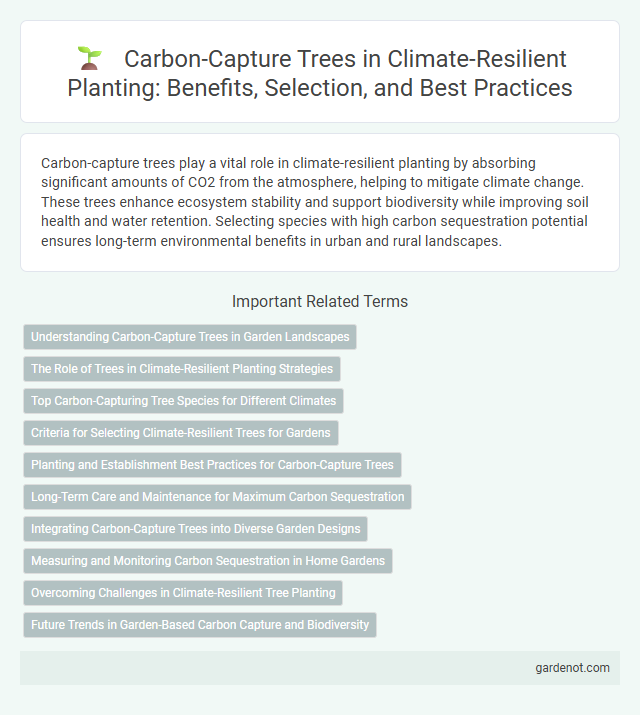Carbon-capture trees play a vital role in climate-resilient planting by absorbing significant amounts of CO2 from the atmosphere, helping to mitigate climate change. These trees enhance ecosystem stability and support biodiversity while improving soil health and water retention. Selecting species with high carbon sequestration potential ensures long-term environmental benefits in urban and rural landscapes.
Understanding Carbon-Capture Trees in Garden Landscapes
Carbon-capture trees in garden landscapes significantly enhance carbon sequestration by absorbing atmospheric CO2 through photosynthesis and storing it in their biomass and soil. Selecting species with high growth rates and deep root systems maximizes carbon uptake while improving soil health and biodiversity. Incorporating these trees into garden designs supports climate resilience by reducing greenhouse gases and promoting sustainable ecosystems.
The Role of Trees in Climate-Resilient Planting Strategies
Trees significantly enhance climate-resilient planting strategies by acting as natural carbon-capture agents, sequestering atmospheric CO2 through photosynthesis and reducing greenhouse gas concentrations. Species such as redwoods, oaks, and mangroves demonstrate high carbon storage capacity, making them essential in carbon management plans. Integrating these carbon-capture trees into urban and rural landscapes boosts ecosystem resilience against climate extremes while improving air quality and biodiversity.
Top Carbon-Capturing Tree Species for Different Climates
Mangroves excel in carbon capture in tropical coastal zones, sequestering up to four times more carbon than terrestrial forests. In temperate regions, species like the Douglas fir and Eastern white pine are top carbon sinks due to their rapid growth and large biomass capacity. Boreal forests benefit from black spruce and tamarack trees, which store significant amounts of carbon in cold, nutrient-poor soils, enhancing climate resilience through ecosystem stability and carbon sequestration.
Criteria for Selecting Climate-Resilient Trees for Gardens
Selecting climate-resilient trees for gardens requires prioritizing species with high carbon-capture capacity, drought tolerance, and adaptability to local soil conditions. Trees like Quercus robur and Acacia senegal excel in sequestering carbon while thriving under variable climate stresses. Ensuring genetic diversity and deep root systems enhances both carbon storage and resilience against extreme weather events.
Planting and Establishment Best Practices for Carbon-Capture Trees
Planting carbon-capture trees requires selecting species with high carbon sequestration potential and adapting them to local soil and climate conditions for maximum growth and carbon storage. Proper site preparation, including soil aeration and nutrient management, enhances root establishment and long-term tree health. Regular monitoring and maintenance, such as mulching and pest control, support robust development and optimize carbon capture over the tree's lifespan.
Long-Term Care and Maintenance for Maximum Carbon Sequestration
Long-term care and maintenance of carbon-capture trees significantly enhance their carbon sequestration potential by ensuring optimal growth conditions and minimizing stress factors such as disease and drought. Implementing regular monitoring, pruning, and soil health management directly supports sustained biomass accumulation and deep root development, which are critical for effective carbon storage. Consistent irrigation and protection from pests further stabilize tree health, maximizing the long-term carbon absorption capacity essential for climate resilience.
Integrating Carbon-Capture Trees into Diverse Garden Designs
Integrating carbon-capture trees such as redwoods, oaks, and black walnuts into diverse garden designs maximizes carbon sequestration while supporting local biodiversity. These trees not only absorb significant amounts of CO2 but also improve soil health and provide habitat for pollinators and wildlife. Selecting species adapted to specific microclimates enhances resilience against climate stressors, promoting long-term sustainability in urban and suburban landscapes.
Measuring and Monitoring Carbon Sequestration in Home Gardens
Measuring and monitoring carbon sequestration in home gardens involves tracking the growth and biomass of carbon-capture trees such as oak, maple, and pine species, which effectively absorb and store atmospheric CO2. Utilizing tools like dendrometers, soil carbon tests, and remote sensing technologies improves the accuracy of carbon stock assessments over time. Consistent data collection supports optimizing tree species selection and planting techniques for maximizing climate-resilient carbon storage in residential green spaces.
Overcoming Challenges in Climate-Resilient Tree Planting
Carbon-capture trees face challenges such as selecting species adaptable to shifting climate zones and ensuring soil health to maximize carbon sequestration. Effective climate-resilient tree planting incorporates drought-resistant and fast-growing varieties to enhance survival rates and carbon storage capacity. Integrating community engagement and advanced monitoring technologies further overcomes implementation barriers and optimizes long-term climate benefits.
Future Trends in Garden-Based Carbon Capture and Biodiversity
Carbon-capture trees designed for garden planting are evolving to enhance carbon sequestration while supporting local biodiversity through adaptive traits and root systems that boost soil health. Advances in genetic research are enabling the development of species with increased photosynthetic efficiency and resilience to climate stressors, promoting long-term ecosystem stability. Integration of these trees in urban gardens creates green corridors that facilitate wildlife habitats and contribute to climate resilience by reducing urban heat and improving air quality.
Carbon-capture tree Infographic

 gardenot.com
gardenot.com